Government

Contact Information:
Tukwila Parks & Recreation
12424 42nd Avenue South
Tukwila, WA 98168
Phone: 206 768-2822
Email Parks & Recreation
Follow us!
Art Walk at Riverton Creek
Art is literally a living element at the recently completed Riverton Flapgate Removal Project, next to and along the Green River Trail.
The City of Tukwila recently removed two culverts – buried drainage pipes – and their gates where Riverton Creek meets the Duwamish River. The work restored the natural flow of the creek, along with improving salmon habitat and passage.
Taking her inspiration from the restoration of the natural habitat, City of Tukwila Artist in Residence, Sarah Kavage created five art pieces. Situated along the riverbank, the work is designed to grow and change, and to become part of the ecosystem rather than standing in opposition to it.
Where to Take in the Art Walk at Riverton Creek
Trail users can take in five art pieces as they make their way east along the Green River Trail between Tukwila International Boulevard and East Marginal Way South. The Riverton Creek restoration sits next to the Duwamish River-crossing of Tukwila International Boulevard. The works include:
A Refuge
If you look carefully from the trail bridge across Riverton Creek at low tide, you’ll see carvings on the debris log closest to the bridge. This carved and dyed cedar log was cut down in service of the restoration and has been placed in the creek as a debris log. Debris logs mimic trees that have fallen into a stream, and create pockets of habitat, shade, and cool water for young salmon.
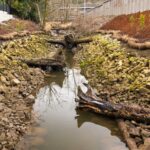
Photo: courtesy of Jason Neuerberg
Freedom of Water
This mural was created in collaboration with multilingual speakers in Tukwila, who were commissioned to contribute texts related to the importance of rivers and water to us all.
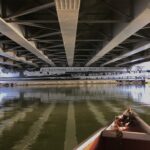
Photo: courtesy of Sarah Kavage
Inspired texts were contributed by: Fathia Abukar (Somali), Chelsea Hendrickson (Lakota and Northern Arapaho), Rose Lulengo (French), Viridiana Alvarado Meija (Spanish), Tina Nguyen (Vietnamese), Natalia Tikhonova (Russian), Kevin Tran (Vietnamese), and Ken Workman and James Rasmussen (Duwamish).
The texts are in English and the language of their contributor, including the following example from Ken Workman and James Rasmussen from the Duwamish Tribe in their Lushootseed language.
xʷi ʔa̓cʔa̓ciłtalbixʷ, xʷi stu̓ləkʷ
xʷi stu̓ləkʷ, xʷi ʔa̓cʔa̓ciłtalbixʷ
“Without a river there is no people. Without our people there is no river.”
Living willow artwork
The remaining three works of art are made with living willow. Willow is a resilient and vigorous plant that thrives along riverbanks. It prevents erosion and creates habitat for birds and fish. There are also many traditions that use willow as a material, including furniture building, live willow weaving, and basketry. The three works along the riverbank draw on each of those traditions. The willow used was wild-harvested within a mile or two of the restoration site.
Water View
Just below the Tukwila International Boulevard bridge is a bench to take in the Duwamish River. Passerby are invited to take a seat. Most of the willow used to build it is planted and will take root and grow, holding the footings in place.
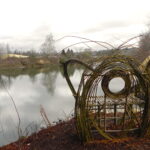
Photo: courtesy of Sarah Kavage
Mother Tree
Along the Green River Trail, roughly halfway between the Tukwila International Boulevard and and East Marginal Way South lays a gorgeous old willow that fell into the water, taking all the neighbor trees with her. The sculptural piece is inspired by ecologist Suzanne Simard’s book Finding the Mother Tree. The book documents that the largest trees in the forest (the mother trees) actually care for their offspring, giving them extra resources to survive. The fallen willow was pruned, and the cuttings were woven back around the mother tree and the riverbank – creating a multigenerational, living sculpture.
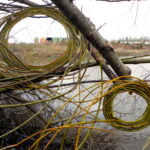
Photo: courtesy of Sarah Kavage
King Tide Orchestra
Farthest along the trail art walk and close to East Marginal Way South lies the final artwork. These sculptures are located right along the high tide line. They can also be seen from the East Marginal Way South bridge crossing the Duwamish River.
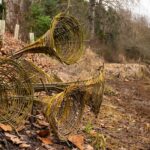
Photo: courtesy of Jason Neuerberg
Locate the Art Walk at Riverton Creek with this map.

